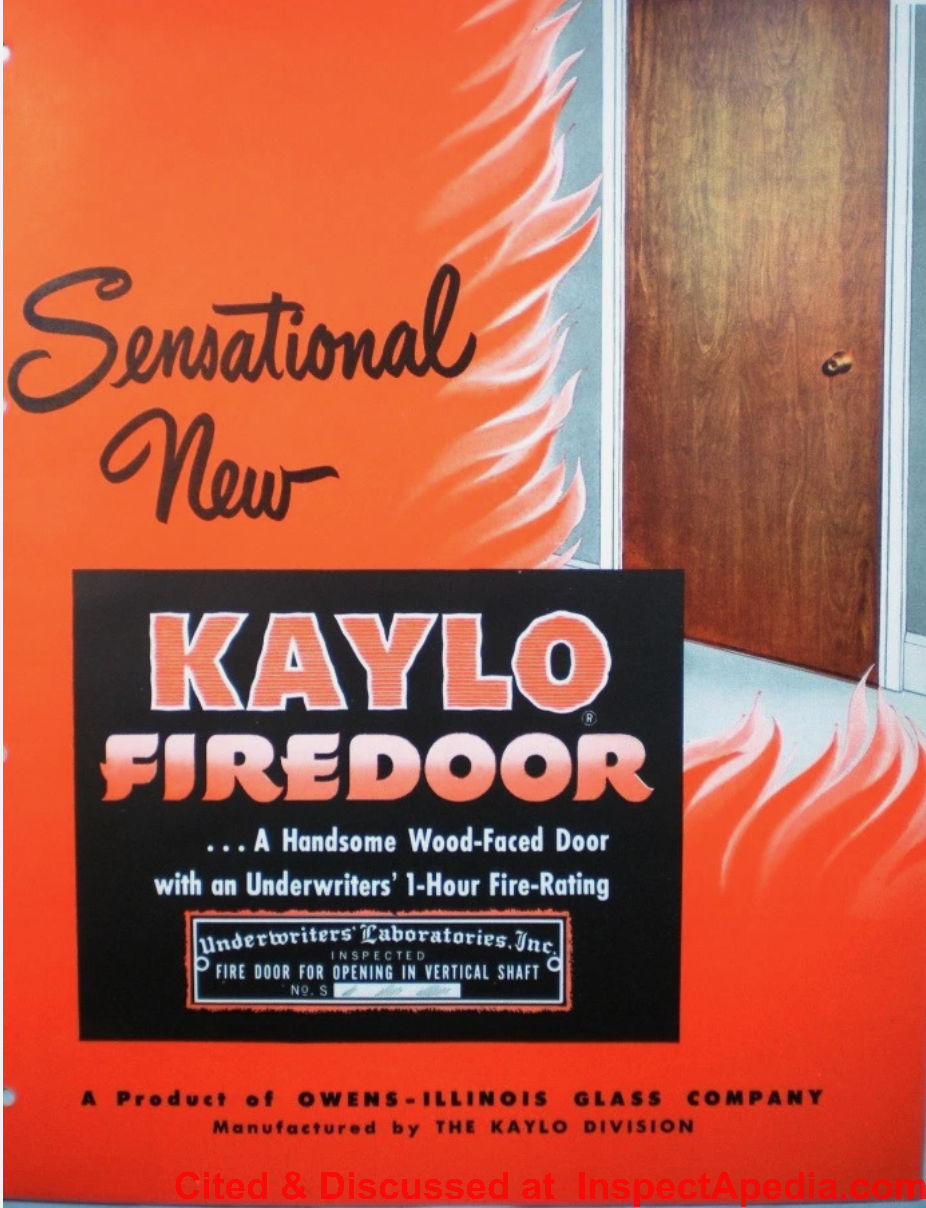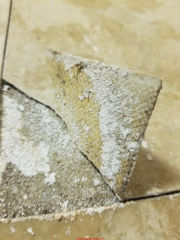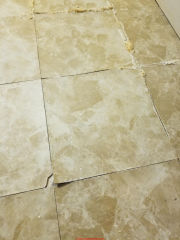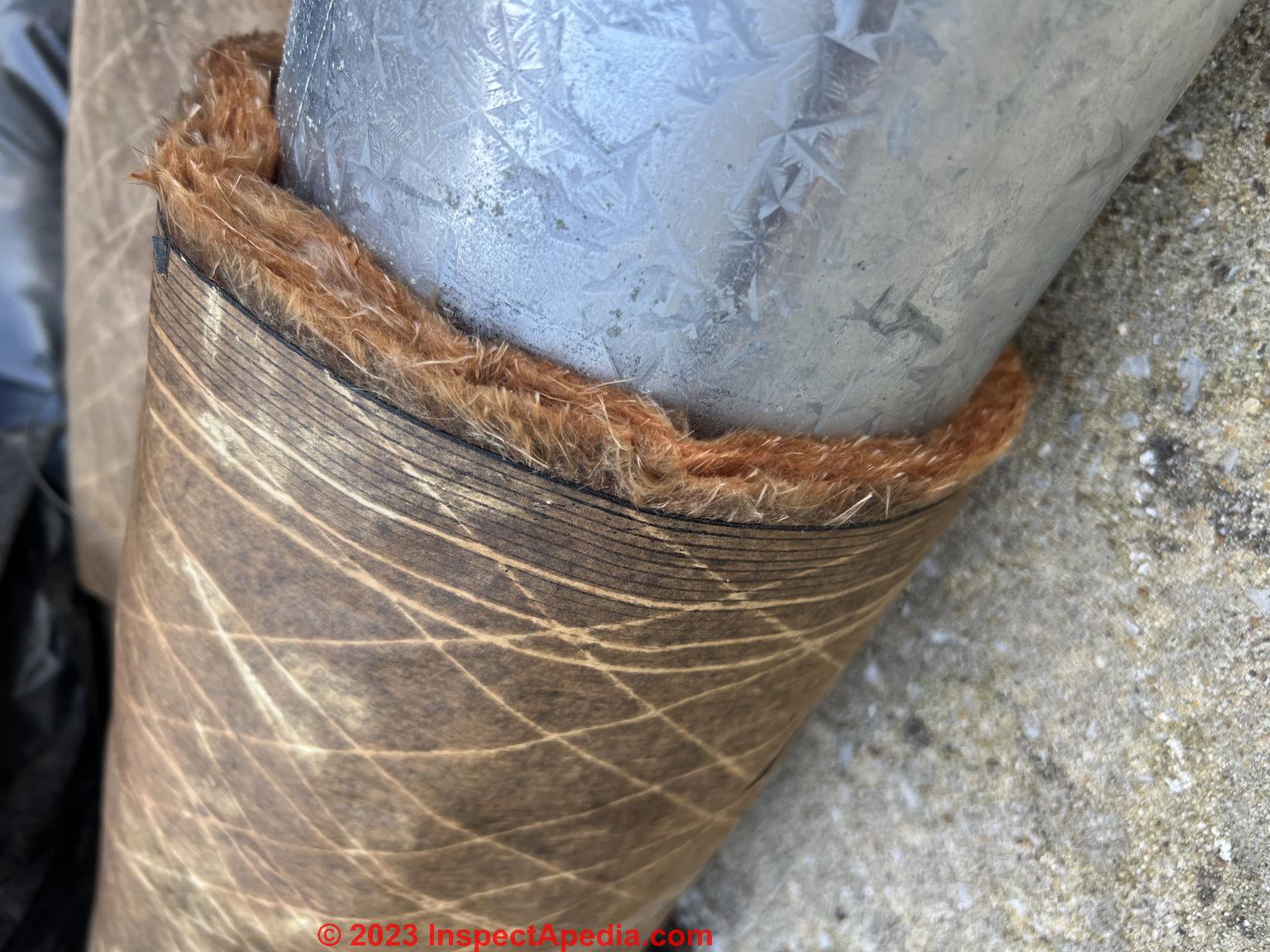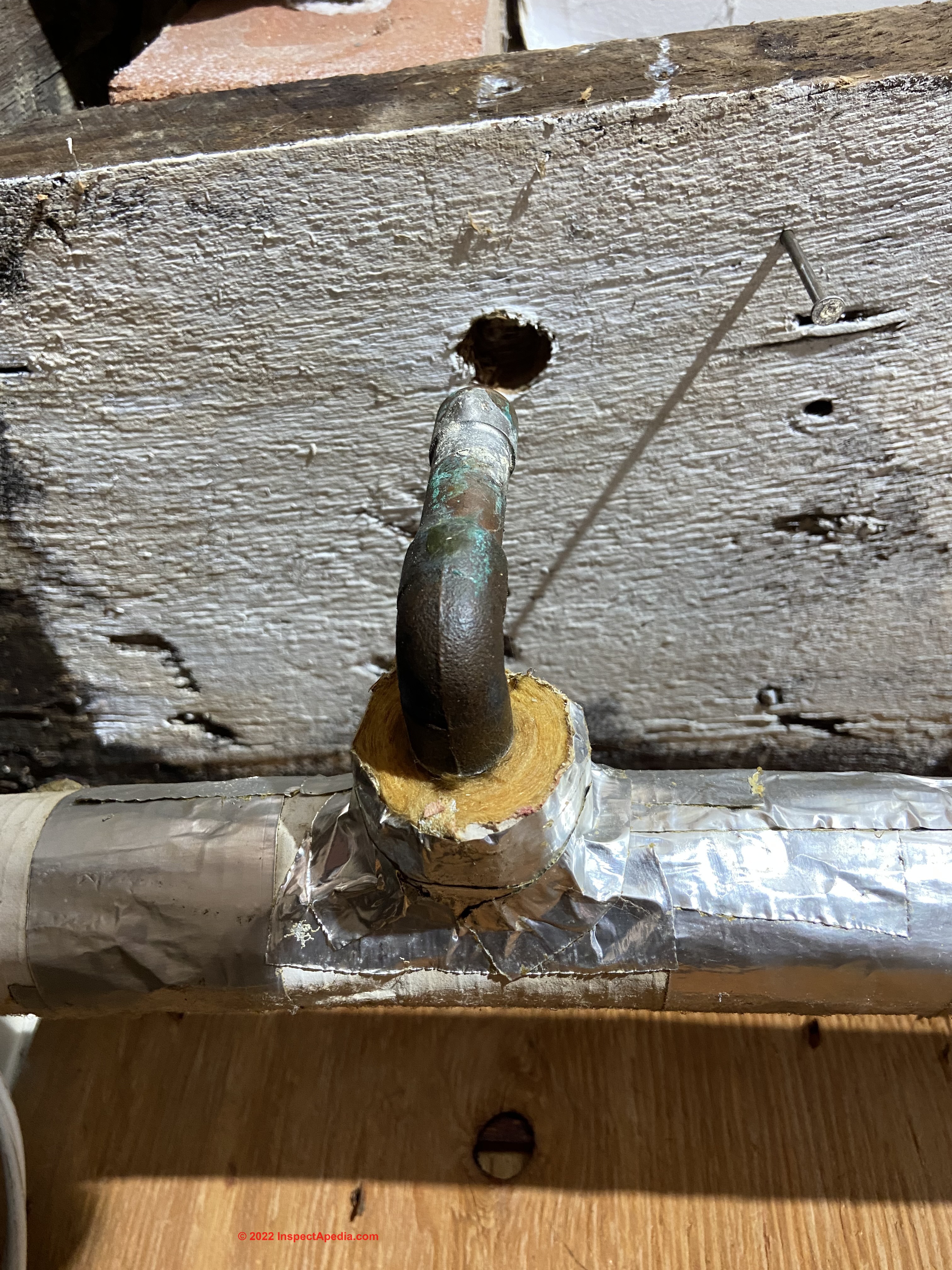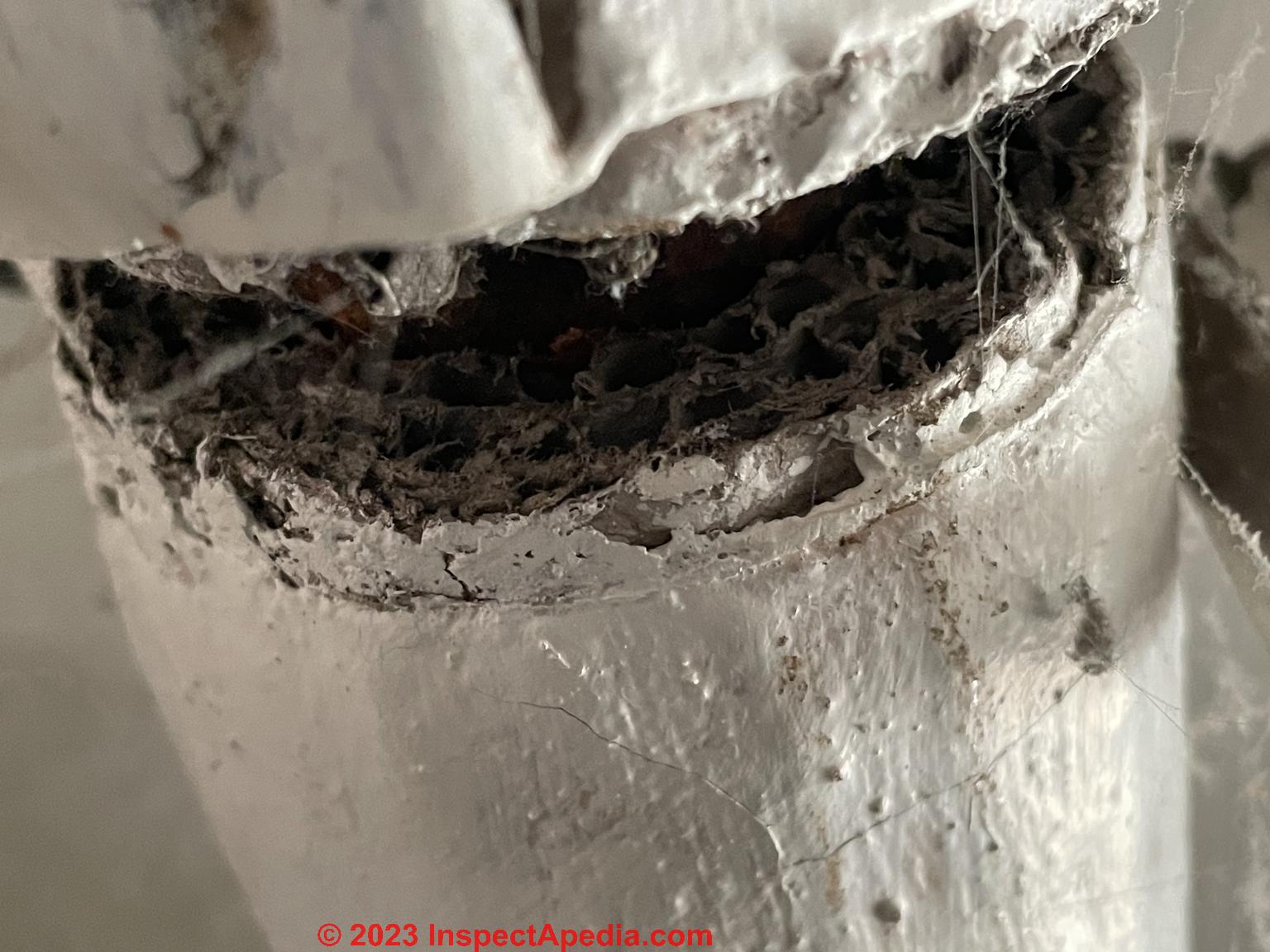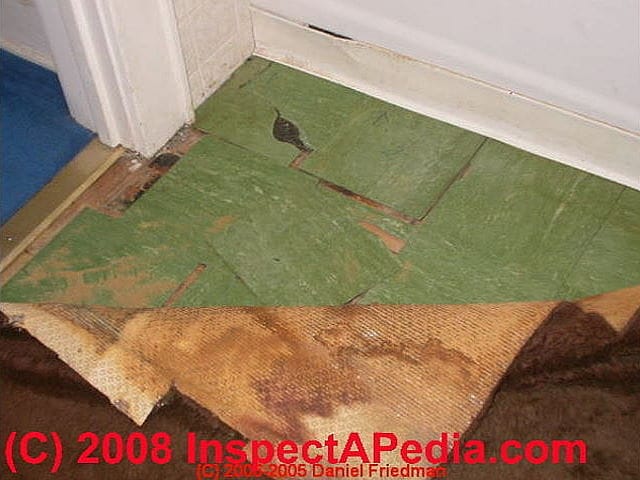 Asbestos-Containing Fiberglass
Asbestos-Containing Fiberglass
or
Fiberglass-Containing Asbestos Products
Research identifies some products combined both asbestos & fiberglass
- POST a QUESTION or COMMENT about products that may have combined asbestos and fiberglass.
Here we discuss the question of whether or not asbestos was ever combined with fiberglass, as indeed it appears to have been in some patent disclosures found in our research.
Page top photo: many readers ask about asbestos in floor tiles; on occasion people ask whether asbestos was combined with fiberglass in floor tile backers, carpet padding, or other building materials.
Short answer: yes, asbestos and fiberglass were occasionally combined, though it's unlikely that you'd find such products in most buildings.
InspectAPedia tolerates no conflicts of interest. We have no relationship with advertisers, products, or services discussed at this website.
- Daniel Friedman, Publisher/Editor/Author - See WHO ARE WE?
Asbestos and Fiberglass Combined in Some Products
If a product such as building insulation, pipe wrap, or floor tile is identified as fiberglass, is that an assurance that it does not contain asbestos?
Usually the answer is yes, if it's fiberglass, it's not asbestos. But as our research cited here documents, there were exceptions to that "rule".
Asbestos was combined with other fibres in products including specialty yarns and fabrics, particularly where heat or fire-resistance was an important design consideration.
Asbestos may have been combined with other fibres including fiberglass as reinforcement in some cementious products as well.
Contemporary fiberglass products including insulating batts and pipe insulation would not contain asbestos.
Research: Asbestos-Fiberglass Combinations in Products
As you can read in the research citations below, the history of combining asbestos and fiberglass materials in various products, possibly (research ongoing) including flooring, dates at least from the 1930's in North America.
- Bailey, G. "Asbestos yarn reinforced with continuous strand of a polyvinyl alcohol." U.S. Patent 3,751,897, issued August 14, 1973.
- Bijwe, Jayashree, and Mukesh Kumar. "Optimization of steel wool contents in non-asbestos organic (NAO) friction composites for best combination of thermal conductivity and tribo-performance." Wear 263, no. 7-12 (2007): 1243-1248.
- Davis, Evelyn Fletcher, Mealey's Litigation Report: Asbestos, Asbestos Litigation and Trust Transparency, an Update [PDF] (2001). Hawkins Parnell, L. L. P. Young, and David E. Freed. Local copy filed as Asbestos-Litigation-Mealey-Davis.pdf
Excerpt:
Asbestos liabilities drove three more companies to file bankruptcy petitions early in 2020:
DBMP LLC, successor to the asbestos personal injury tort liabilities of the former CertainTeed, a manufacturer of cement and asphalt roofing products;1
ON Marine Services Co. LLC,2 successor of a company that manufactured a specialized insulation product used in steel mills; and Paddock Enterprises, LLC, successor of an entity that manufactured Kaylo insulation products from 1948 to 1958.3
- Geier, Ernest C., and Rudolph E. Semmler. "Yarn." U.S. Patent 2,350,504, issued June 6, 1944.
Excerpts: asbestos and glass threads that the advantageous properties of these materials are combined ... - Gibbons, Willis A. "Asbestos yarn." U.S. Patent 2,179,087, issued November 7, 1939.
Excerpt: Method of producing combined asbestos and glass fiber yarns - Haney, James C. "Asbestos Elimination in a Glass Plant." In 41st Conference on Glass Problems, vol. 321, p. 30. John Wiley & Sons, 2009.
Text includes "Asbestos Fiberglass Floor tile Asbestos tile Vinyl tile high temp." - Hoopes, Harry P. "Reinforced cementitious insulating material and method of preparation thereof." U.S. Patent 2,747,994, issued May 29, 1956.
- Morrison, Albert R., and Richard F. Shannon. "Coated fabrics." U.S. Patent 2,662,044, issued December 8, 1953.
- further research & citations needed - Ed.
- Haney, James C. "Asbestos Elimination in a Glass Plant." In 41st Conference on Glass Problems, vol. 321, p. 30. John Wiley & Sons, 2009.
Text includes "Asbestos Fiberglass Floor tile Asbestos tile Vinyl tile high temp." - Hoopes, Harry P. "Reinforced cementitious insulating material and method of preparation thereof." U.S. Patent 2,747,994, issued May 29, 1956.
- Johns-Manville; several mesothelioma lawsuit focused law firms include on their web pages the assertion that that JM's fiberglass insulation contained asbestos into the 1980's. Pages that we reviewed in April 2025 indeed included that text but with no supporting independent scholarly citation.
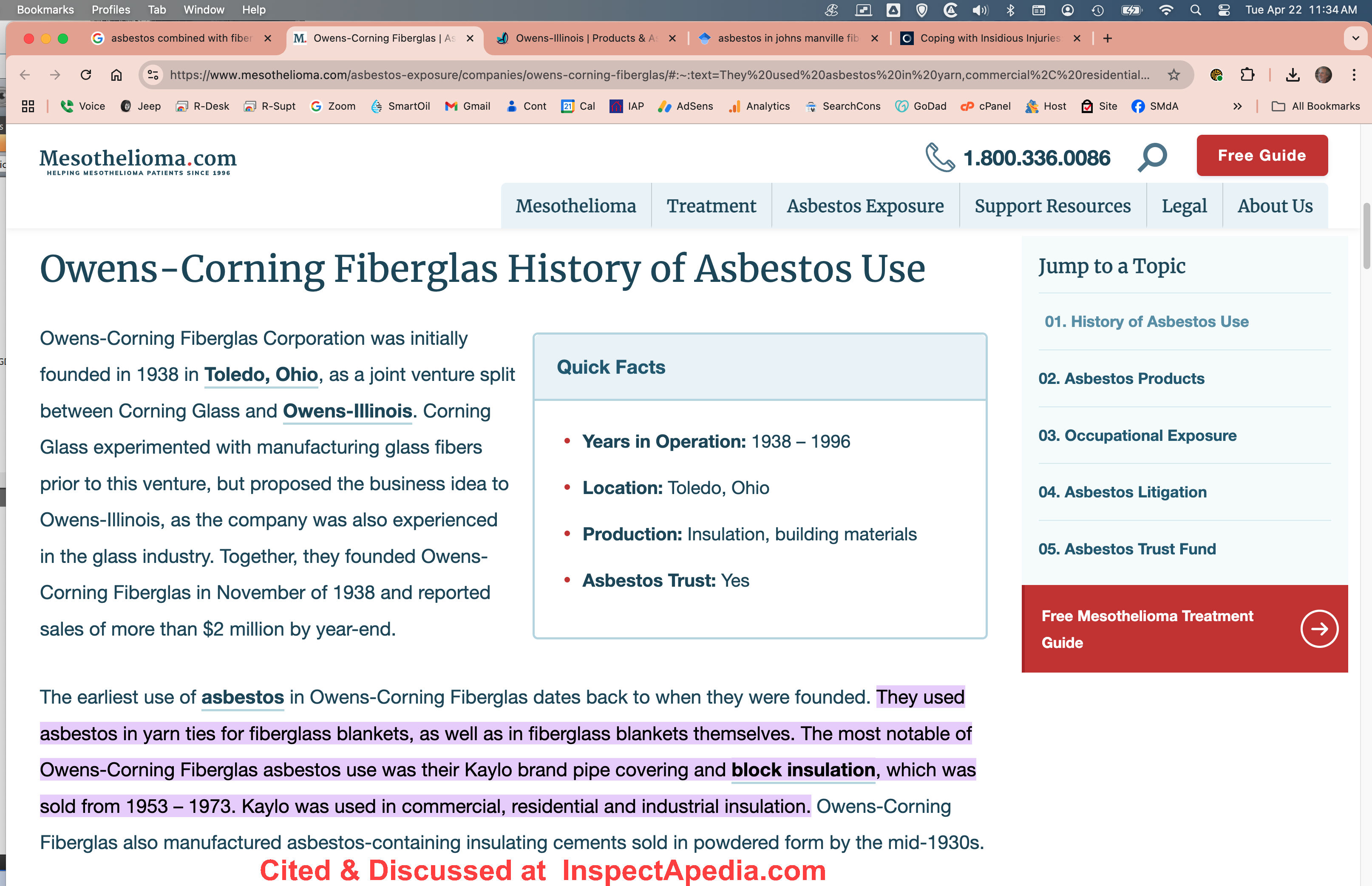
Other pages cited by Google Search in response to our query "asbestos mixed with fiberglass" produced web pages purported to document such a mix but in fact a look at actual web page text found no such assertion but rather the appearance of both words "asbestos" and "fiberglass" in proximity in the text.
(If you have research citations documenting the deliberate mix or combination of fiberglass with asbestos please let us know - Ed.)
Current J-M fiberglass insulation will not contain asbestos. - Johns-Manville THERMO-12 Asbestos-Free Pipe & Block Insulation [PDF] confirmed that this product did not use asbestos.
Excerpt:
[J-M Thermo-12 was described as] A molded, high temperature pipe and block insulation, J-M Thermo-12 is composed of hydrous calcium silicate. It is an insulating material w hich, because of its light weight, low thermal conductivity, great structural strength and insolubility in water, is ideal for high temperature piping and equipment. - Morrison, Albert R., and Richard F. Shannon. "Coated fabrics." U.S. Patent 2,662,044, issued December 8, 1953.
- further research & citations needed - Ed.
- Mathes, K. N., and H. J. Stewart. "Asbestos and glass-fiber magnet-wire insulation." Electrical Engineering 58, no. 6 (1939): 290-294.
- Novak, Izador J. "Production of composite glass and asbestos yarn." U.S. Patent 2,778,763, issued January 22, 1957.
Excerpt:
This invention relates to the production of novel composites of glass fibers and asbestos fibers, and more particularly to the production of fiber glass yarn of new and improved character comprised of glass filaments and fine chrysotile asbestos fibers, wherein the glass filaments are coated with and spaced apart by dry residue of a liquid dispersion of chrysotile asbestos fibers principally of colloidal diameter, i. e. discrete asbestos fibers of from about .02 to about .05 microns in diameter, termed herein unit fibers.
-
Owens Illinois Glass Company's Kaylo Pipe Covering and Kaylo block insulation produced from 1940 to ca. 1972 or possibly 1973, contained as much as 20% asbestos, principally chrysotile asbestos and a smaller amount of amosite asbestos.
Kaylo contained both amosite (12% per volume) and chrysotile (3% per volume) asbestos fibers. (Weglar 2021)Amosite / Chrysotile Asbestos Kaylo Insulation Products
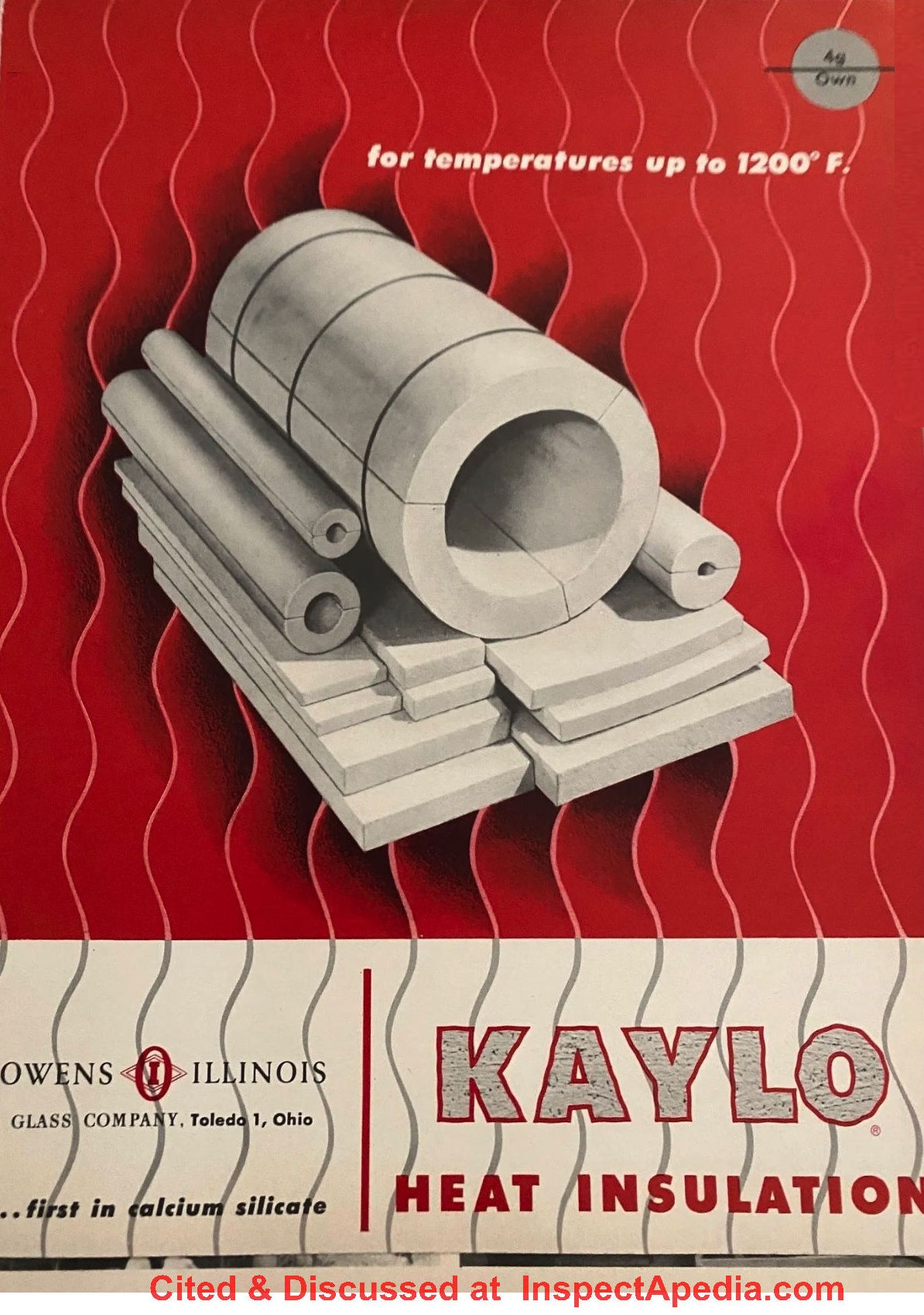
Asbestos-based Kaylo block was used as the insulating core in Owens-Illinois Glass Company's Kaylo Firedoor in the 1950s and up to about 1973Note that when completely enclosed such as in the core of a fire door there should be no detectable asbestos hazard from the door as long as it is left intact.

Asbestos-based Kaylo block was also used in some doors as an insulating core by other door manufacturers such as by Overly Manufacturing Company.
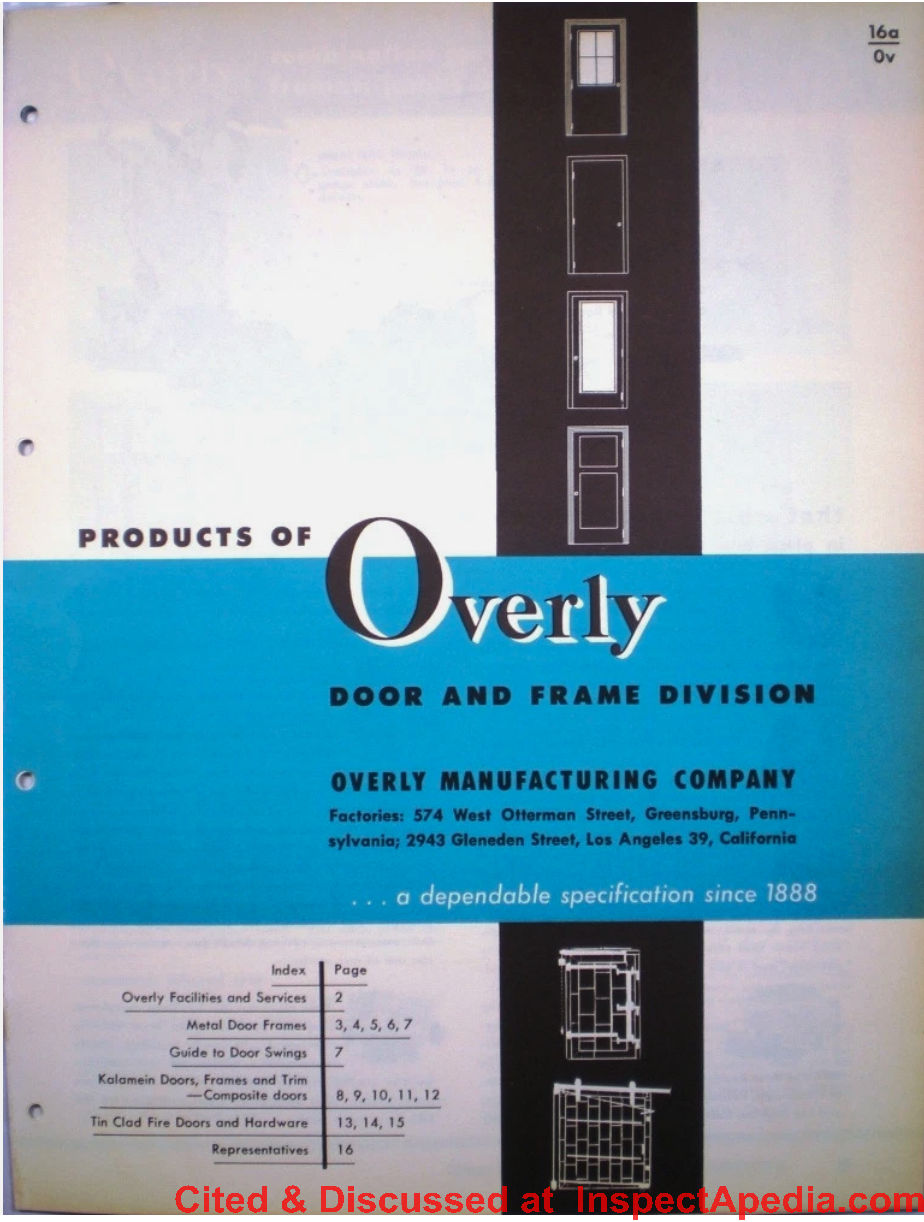
Above: Some Overly brand labeled [certified as fire-rated] flush type doors sued a core made of Kaylo, the fiberglass/asbestos product we're describing here. Here's an excerpt from the Overly product catalog shown above:
Labeled Flush Type Doors [Image of catalog page text] Cores shall be made of 20-pound density, 1 11/16" thickness, incombustible mineral material known under the trade name of KAYLO, and manufactured by Owens-Illinois Glass Company. This door shall be sanded on each face to provide a perfectly smooth and level surface on both sides to receive metal covering as hereinafter specified.Really? OPINION: It's probably worth noting that if your building has Kaylo insulation that is in good condition, undisturbed, or encapsulated (including inside of a door) it's likely that there's no measurable asbestos exposure from that product in that condition.
The litigation discussing asbestos hazards including from what originally were considered "low exposure" (today probably not considered "low"), focused on exposure of workers in factories where Kaylo products were produced. (Weglarz 2021)
Asbestos Free KAYLO Products
By 1972 at least some Kayo products did not contain asbestos as you can read in this product description for:
KAYLO 10 ASBESTOS FREE PIPE INSULATION [PDF] Commercial D.11, October 1972
Excerpt:
Kaylo10 Asbestos Free* is particularly suitable on high temperature pipeing systems where high performance and extended temperature ranges are required.
* Kaylo10 Asbestos Free is a trademark of Owens-Corning Fiberglass Corp.
- Schneider Andre, French Patent Publication No. FR2416113A2, 1979-08-31 Dust-free fabric based on asbestos - is woven from asbestos yarn sheathed in yarn from glass fibres
- Schneider Andre, French Patent Publication No .FR2405817A1 1979-05-11 Non-dusting asbestos fibre assemblies - with the asbestos enclosed in glass fibre filaments by plating etc.
- Simpson, Donald C. "Combined asbestos and glass fiber yarn." U.S. Patent 2,132,702, issued October 11, 1938.
Excerpts:
I have discovered that the above mentioned individual shortcomings of the asbestos and glass fibers may be overcome by a combination of the two, and that a superior product, having properties superior to any of the individual properties of the ingredients, may be produced by a combination of the two types of fibers.
Another object of the invention is the provision of a fabric composed of inorganic fibers which may be fabricated into felt or interwoven tape suitable for electrical, heat and/or sound insulation.
Another object of the invention is to utilize the softness, pliability and yieldability more naturally inherent in the asbestos fibers in combination with glass fibers, which are much stronger and longer than the asbestos fibers.
The individual glass fibers are sufficiently fine and long so that they may be intertwisted or interfelted with the asbestos fibers to form strong yarns which may be safely subjected to the rigors of a conventional loom.
The asbestos fibers serve as cushions for the adjacent glass fibers to assist in the distribution of load - SPARKS v. OWENS ILLINOIS INC (1995) Docket No: No. A056656. Decided: January 17, 1995 Court: Court of Appeal, First District, Division 2, California. [PDF]
Excerpt: Appellant Owens–Illinois made and sold a product known as “Kaylo” between 1948 and 1958. Kaylo was a calcium silicate insulation, made with 13 to 20 percent asbestos, which was sold in pipe-covering and block forms, and intended to be used for “industrial high[-]temperature thermal insulation.”
The asbestos used in Kaylo was predominantly of the chrysotile variety but amosite was also used to a lesser extent.
Owens–Illinois never made asbestos-containing products other than Kaylo pipe covering and block.
Owens–Illinois sold its Kaylo operation to Owens–Corning Fiberglass in April 1958. Owens–Corning Fiberglass continued to make and sell Kaylo pipe covering and block insulation after April 1958. The Kaylo products were made for Owens–Corning Fiberglass by Fibreboard Corp. from 1960 to 1972.
[Really? NOTHING in this document asserts that fiberglass was combined with asbestos in the product. The word "fiberglass" appears three times in the document, all of those in the paragraph above - Ed.] - Turner Newall, Limpet Spray combined fiberglass with 85% asbestos. Turner Newell, U.K. in business from 1871 to 2001, was the first UK firm to produce asbestos cloth with power-driven machinery and using asbestos form the company's asbestos mine in Eswatini, South Africa. [Wikipedia 2025/04/22]
Limpet spray contains 85% asbestos fibres combined with adhesive as an asbestos-spray coating. Limpet spray asbestos was widely used in construction in the UK including Australia beginning in the 1930's.
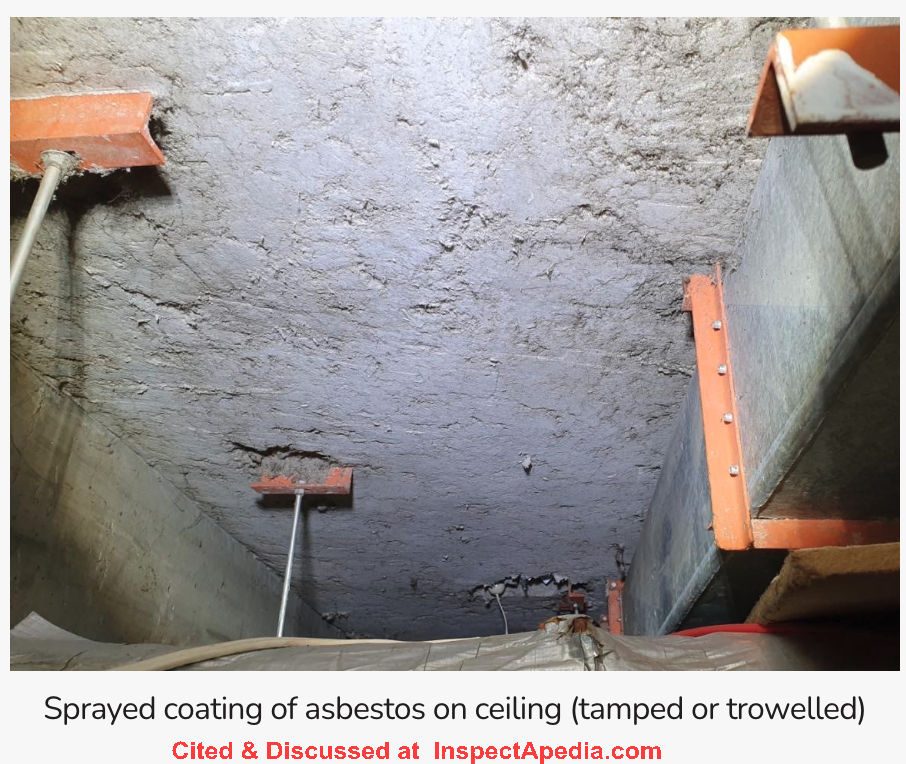
An example of Limpet spray provided by the Australian government's asbestos product guide [Website] - Australian Asbestos and Silica Safety & Eradication Agency, Web: https://www.asbestossafety.gov.au/ lists asbestos spray insulation products produced by Bradford Insulation Industries, Silbestos (CSR), Asbestospray, and multiple Limpet spray products from which these two photos are excerpted. - retrieved 2025/04/22.
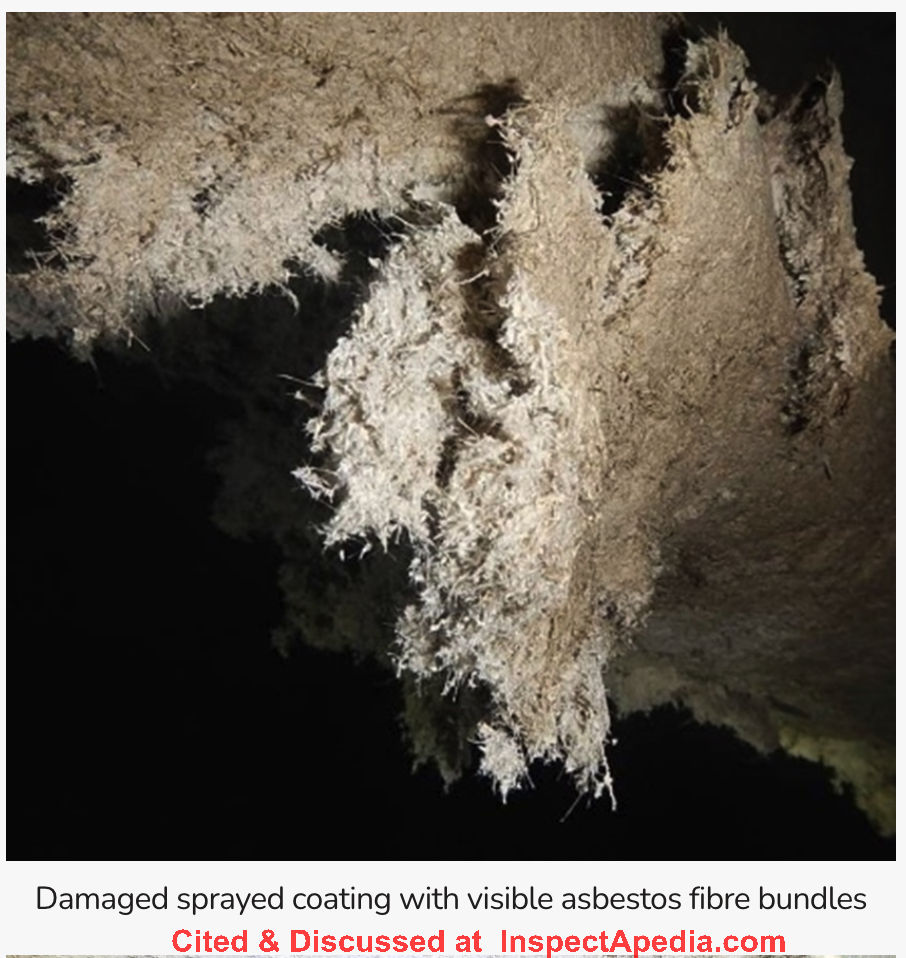
- Weglarz, Claire C., Mealey's Litigation Report: Asbestos, Getting Back to Basics: Evidence-Based Science in the Courtroom [PDF] (2021) Hawkins Parnell, and L. L. P. Young. Local copy filed as Asbestos-Litigation-Mealey-Weglarz.pdf
Excerpt:
The product at issue in Rutherford was Kaylo, an asbestos-containing insulation product manufactured by Owens-Illinois from 1948 to 1958.32
Kaylo contained both amosite (12% per volume) and chrysotile (3% per volume) asbestos fibers.33 [Citing William E. Longo et al., MAS Work Practice Study: Kaylo III (Oct. 2006). - Ed.]
Kaylo work practice studies have measured airborne concentrations of asbestos fibers equal to or greater than 5 microns ranging from 20 f/cc (hand sawing) to 70 f/cc (clean up).34 Airborne concentrations for these same activities measured in the field have been reported to be much higher: 158 f/cc (hand sawing) and 1191 f/cc (clean up).35
Several studies36 have concluded that airborne concentrations of asbestos fibers associated with insulation products like Kaylo increase incidence of cancer.
The evidence in Rutherford was that work with insulation products like Kaylo created areas of asbestos dust that looked like a “Texas dust storm.”37
Reader Comments, Questions & Answers About The Article Above
Below you will find questions and answers previously posted on this page at its page bottom reader comment box.
Reader Q&A - also see RECOMMENDED ARTICLES & FAQs
If floor tile contains fiberglass can I assume it does not contain asbestos?
Any thoughts on this tile? Appears to be vinyl with a fiber (glass, I hope) backing. House was built in 1978 but likely had basement finished (and tile put down) later than that. In Detroit metro area. Water has caused adhesive to dissolve and come up, appears white. 2020/04/11 Dave...
Reply: NO, not quite: but fiberglass and asbestos may have been used together in some products including floor tiles & ceiling tiles, gaskets, ropes, fabrics
White backer on a vinyl floor tile made before the end of the 1980's may contain asbestos. I'd treat the floor thus or have a sample tested.
Fiberglass was combined with asbestos in some products
Although the use of long asbestos fibers diminished in most countries as fiberglass became more-commonly-available, both products continued in use, sometimes together as this research illustrates.
Unfortunately, although the combination of asbestos and fiberglass in flooring is uncommon, or at least has not been widely reported, we cannot absolutely assure you that if fiberglass is present in a floor tile that asbestos is absent.
A practical example might be (and this is speculative on my part - DF) that asbestos and fiberglass might have been combined in an asbestos-containing tile or sheet flooring backer.
Asbestos combined with fiberglass as carpet backer or padding?
I was told that matting may have been made with asbestos and fiberglass. I'm assuming this carpet has been laid around 1985-1990? 2023-06-05 by Red
Reply: need citation that states carpet padding in some cases was made by combining asbestos and fiberglass
@Red,
Thank you for the question.
If you could go back to the source or person who told you that carpet padding in some cases was made by combining asbestos and fiberglass, and ask them for any source or citation or reference supporting that assertion, that would be very helpful as that's not a product that we have found.What we have found on this question is documented above on this page.
Is this HVAC duct insulation asbestos?
This insulation is wrapped around the HVAC ductwork in my home. Built in the mid 70s. Do you think this is asbestos insulation? 2023-01-16
by Davis L
Reply: No, that is jute insulation
@Davis L,
That looks like Jute or a similar insulating product. It is not asbestos and not likely to contain asbestos.
Can there be some asbestos fibers mixed in pipe insulation in a 1912 Toronto Canada Home?
First of all, I wanted to thank you immensely for your wonderful database. I'm grateful for all the wonderful information your provide. I truly can't thank you enough!
Secondly, I would like to seek your help regarding identifying the material in the three photos I've attached to this email. They're all pipe insulation found in my basement around regular (mostly) copper water supply pipes.
I'm concerned about the insulation itself but also the white paper or plastic wrap that is also degraded and being reinforced with packing and/or aluminum tape.
The bit that concerns me most is the most damaged insulation around the pipe coming right out of the water meter. They may have been added at different times.
I suspect it's all fiberglass and the tape or casing is plastic or paper but perhaps it's asbestos or asbestos containing material.
I'm no expert and I'm not sure about the oldest bit by the water meter in particular.
We only bought the house a year ago. I also know from some research that even the fiberglass insulation can have asbestos in it.
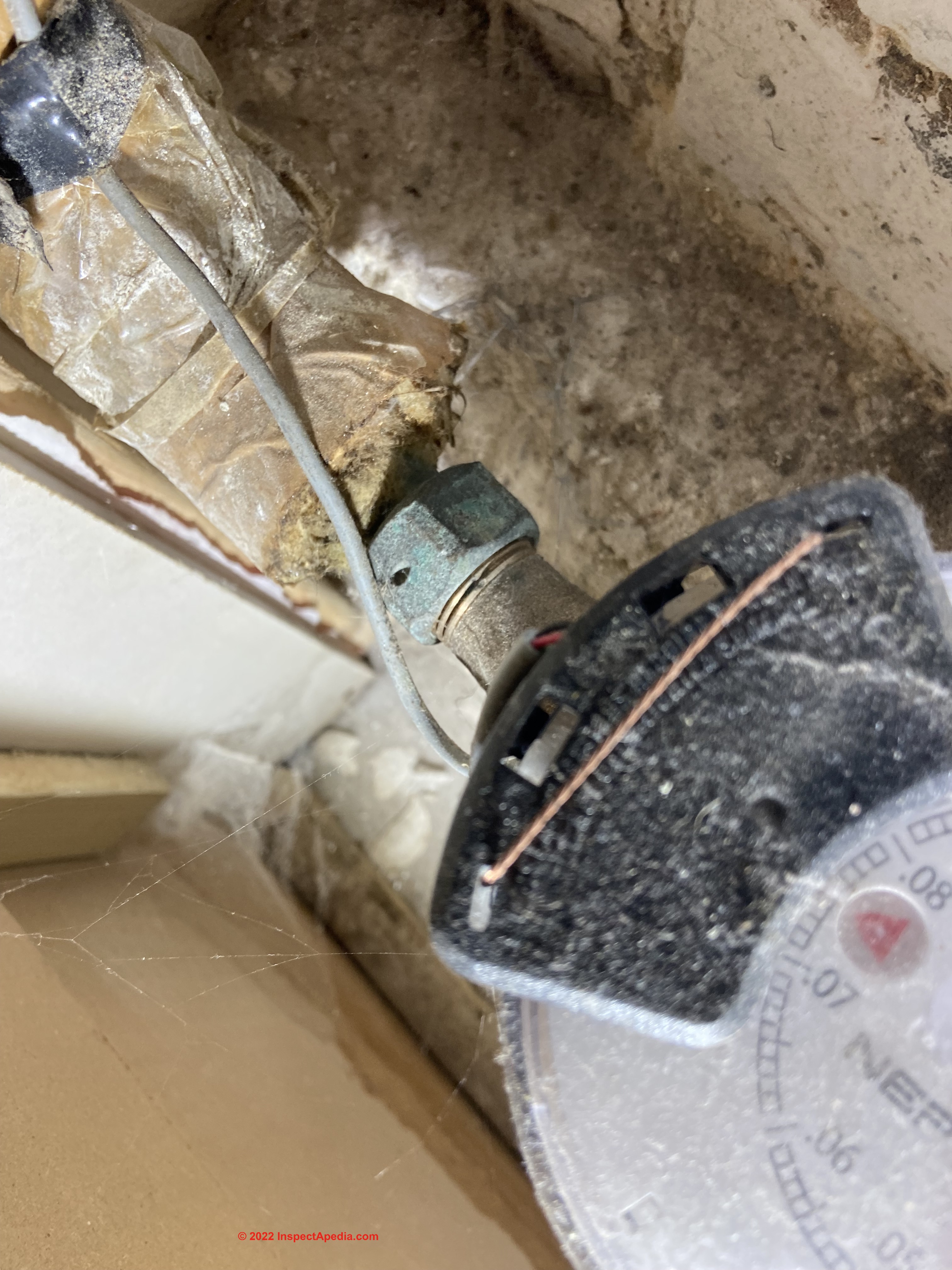
This is simply black mastic or whatever you call it and I don't see that in the insulation in my house, though I've not torn it to look underneath so I can't be sure.
What I'm wondering is whether there can be some asbestos fibers mixed into this insulation especially the bit by the water meter, independent of any black mastic. I've lost count of all the things asbestos fibers were added to and perhaps this fiberglass insulation is among them.
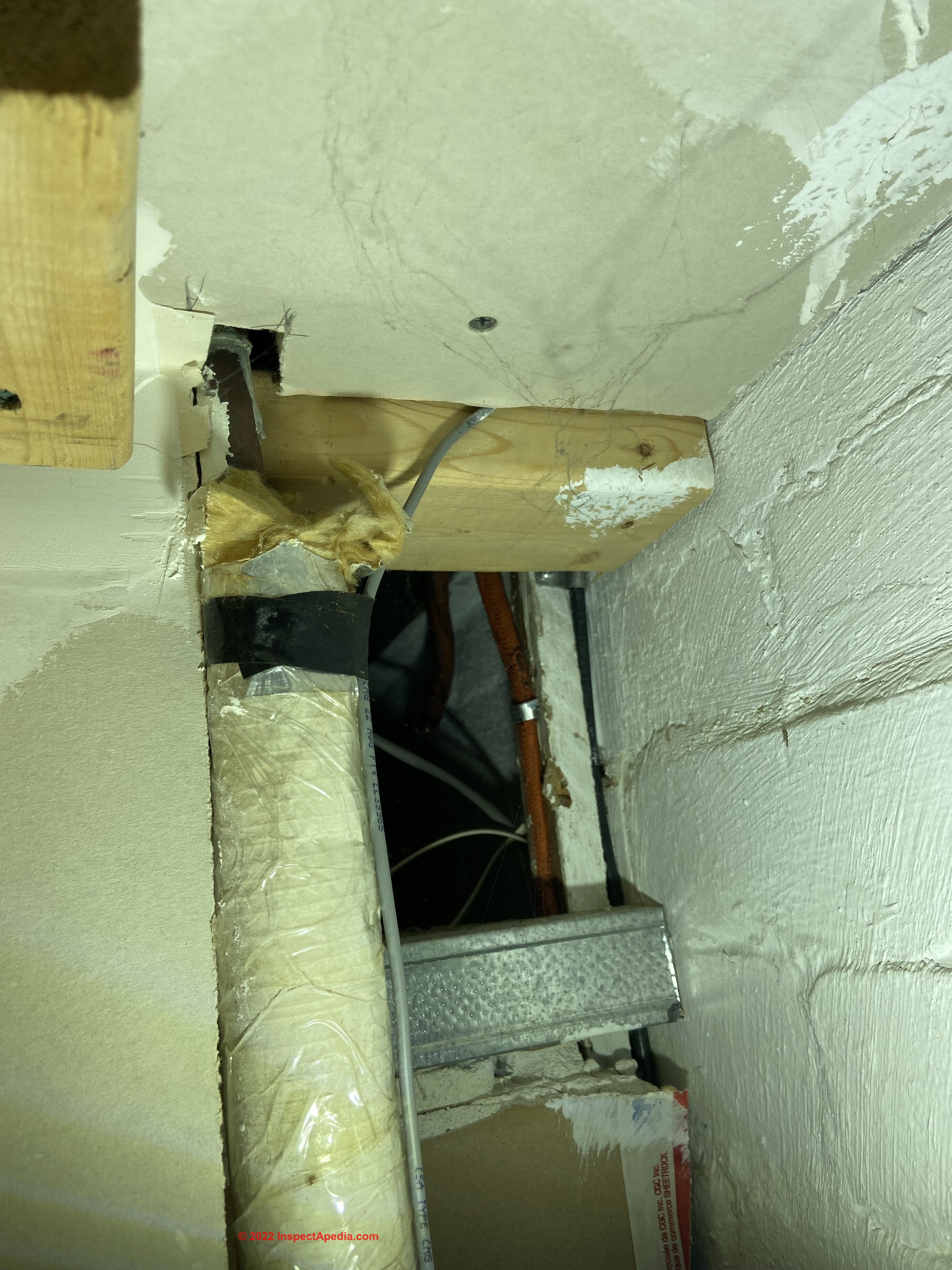
I would very much appreciate your help with this matter since we have upcoming renovations next week or the one after that will involve this section of the basement.
The house was built in 1912 but, of course, there have been several renovations over the years in bits and pieces so to speak. It's a two-story, two-bedroom house. It's located in Toronto, Ontario, Canada. 2022-06-19
by Anon
Reply: Your photos show what looks like common fiberglass / plastic / paper / foil insulating pipe wrap products
@Anonymous
On or in a house that old certainly there could have been any number of asbestos-containing products, including drywall and joint compound visible in one of your photos.
But the pipe insulation in your photos looks like fiberglass and common fiberglass /plastic/paper/foil wraps.
Take a look at our photos of ASBESTOS PIPE INSULATION
Separately, at FIBERGLASS INSULATION IDENTIFICATION & PROPERTIES we gave our OPINION that Generally fiberglass insulation does not contain asbestos unless by cross-contamination.
Asbestos pipe insulation typically looks like this photo showing the classic "corrugated cardboard" shape into which asbestos-based paper was formed to make an insulating pipe wrap widely used on heating pipes and some water pipes in buildings.
Note: asbestos fibres may be found in old mastic adhesives - as you've read, though that material is not normally friable so doesn't release particles to the air except if disturbed such as by demolition.
Note: asbestos could well be in drywall and joint compound and possibly in a foundation waterproofing paint in your home, depending on the age of those materials.
And of course asbestos was used in thousands of other products.
That's not a reason to be frightened. It's a reason to avoid disturbing suspect materials, cover them, or if there must be demolition, then use appropriate procedures.If you have authoritative unbiased research confirming that there is asbestos in fiberglass insulation, please send me that reference so that we can review and include it here.
Fiberglass and asbestos were combined in some products, particularly fabrics and yarns.
See the article above on this page.
In sum, the presence of fiberglass fibers as an ingredient in some products does not allow us to rule out the presence of asbestos in those products as well, but frankly it's not highly likely in most building insulation products. - Daniel Friedman
...
...
Continue reading at ASBESTOS IDENTIFICATION IN BUILDINGS - home , or select a topic from the closely-related articles below, or see the complete ARTICLE INDEX.
Or see these
Recommended Articles
- ASBESTOS IDENTIFICATION IN BUILDINGS - home
- ASBESTOS DISPOSAL REGULATIONS
- ASBESTOS FLOORING IDENTIFICATION GUIDE INDEX - all brands, all years
- ASBESTOS IN MINERAL WOOL / STONE WOOL
- ASBESTOS INSULATION
- ASBESTOS TESTING LAB LIST
- DOES THIS MATERIAL CONTAIN ASBESTOS? - 5 easy questions to tell if a BUILDING MATERIAL probably contains asbestos -
- FIBERGLASS ASBESTOS COMBINATIONS
- FIBERGLASS HAZARD RESEARCH
- FIBERGLASS INSULATION IDENTIFICATION & PROPERTIES
Suggested citation for this web page
FIBERGLASS ASBESTOS COMBINATIONS at InspectApedia.com - online encyclopedia of building & environmental inspection, testing, diagnosis, repair, & problem prevention advice.
Or see this
INDEX to RELATED ARTICLES: ARTICLE INDEX to ASBESTOS HAZARDS
Or use the SEARCH BOX found below to Ask a Question or Search InspectApedia
Ask a Question or Search InspectApedia
Try the search box just below, or if you prefer, post a question or comment in the Comments box below and we will respond promptly.
Search the InspectApedia website
Note: appearance of your Comment below may be delayed: if your comment contains an image, photograph, web link, or text that looks to the software as if it might be a web link, your posting will appear after it has been approved by a moderator. Apologies for the delay.
Only one image can be added per comment but you can post as many comments, and therefore images, as you like.
You will not receive a notification when a response to your question has been posted.
Please bookmark this page to make it easy for you to check back for our response.
IF above you see "Comment Form is loading comments..." then COMMENT BOX - countable.ca / bawkbox.com IS NOT WORKING.
In any case you are welcome to send an email directly to us at InspectApedia.com at editor@inspectApedia.com
We'll reply to you directly. Please help us help you by noting, in your email, the URL of the InspectApedia page where you wanted to comment.
Citations & References
In addition to any citations in the article above, a full list is available on request.
- "Asbestos in your home or at work," Forsyth County Environmental Affairs Department, Winston-Salem NC12/08
- "Asbestos Floor Tile Removal", the University of Minnesota's advice on removing VAT (vinyl asbestos or asphalt asbestos floor tile) can be read in detail at www.health.state.mn.us/divs/eh/asbestos/floortile/index.html
- EPA, ASBESTOS IN YOUR HOME [PDF] - U.S. EPA, Exposure Evaluation Division, Office of Toxic Substances, Office of Pesticides and Toxic Substances, U.S. Environmental Protection Agency, Washington,D.C. 20460
- Resilient Floor Covering Institute, 1030 15th St. NW, suite 350, Washington D.C.
- MANAGING ASBESTOS in PLACE: A Building Owner's Guide to Operations and Maintenance Programs for Asbestos-Containing Materials ("Green Book"), web search 08/11/2010, original source: http://www.epa.gov/asbestos/pubs/management_in_place.html
How to Develop and Maintain a Building Asbestos Operations and Maintenance (O&M) Program, This information is designed to assist building owners and managers in understanding how to develop and maintain an operations and maintenance program for asbestos-containing materials in their buildings. - Monitoring Asbestos-Containing Material (ACM), U.S. EPA, web search 08/11/2010, original source: http://www.epa.gov/asbestos/pubs/section6.html quoting:
Periodic Visual Reinspections and Air Monitoring
A visual reinspection of all ACM should be conducted at regular intervals as part of the O&M program to help ensure that any ACM damage or deterioration will be detected and corrective action taken. - In addition to citations & references found in this article, see the research citations given at the end of the related articles found at our suggested
CONTINUE READING or RECOMMENDED ARTICLES.
- Carson, Dunlop & Associates Ltd., 120 Carlton Street Suite 407, Toronto ON M5A 4K2. Tel: (416) 964-9415 1-800-268-7070 Email: info@carsondunlop.com. Alan Carson is a past president of ASHI, the American Society of Home Inspectors.
Thanks to Alan Carson and Bob Dunlop, for permission for InspectAPedia to use text excerpts from The HOME REFERENCE BOOK - the Encyclopedia of Homes and to use illustrations from The ILLUSTRATED HOME .
Carson Dunlop Associates provides extensive home inspection education and report writing material. In gratitude we provide links to tsome Carson Dunlop Associates products and services.


